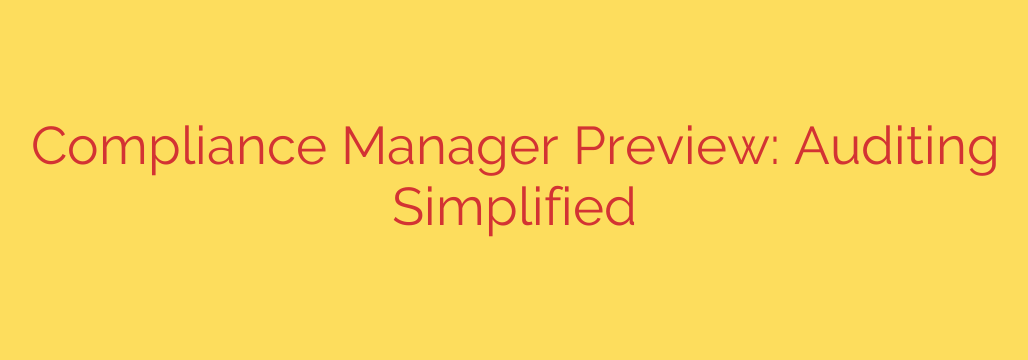
Mastering Regulatory Compliance: Your Guide to Simplified Auditing and Risk Management
Navigating the complex maze of industry regulations and data protection standards is one of the greatest challenges facing modern organizations. With rules like GDPR, HIPAA, and ISO 27001 constantly evolving, maintaining compliance can feel like a full-time job. Traditional methods involving spreadsheets and manual checklists are no longer sufficient—they are inefficient, prone to error, and leave your organization vulnerable to significant risks.
The key to overcoming this challenge lies in shifting from a reactive to a proactive compliance strategy. A modern compliance management solution provides a centralized, intelligent platform to help you understand your risk landscape, streamline auditing, and continuously improve your data protection posture.
The Core Challenge: A Lack of Clarity and Control
For many IT and security teams, the compliance process is fragmented. Information is scattered across different departments, assessments are performed infrequently, and it’s difficult to get a clear, up-to-the-minute picture of the organization’s compliance status. This leads to several critical problems:
- Manual Evidence Collection: Teams spend countless hours manually gathering evidence for audits.
- Complex Regulations: Translating dense legal and regulatory requirements into specific technical controls is a major hurdle.
- No Real-Time Visibility: You often don’t know you have a compliance gap until an audit is already underway.
- Increased Risk: Without continuous monitoring, vulnerabilities can go unnoticed, exposing the organization to data breaches, financial penalties, and reputational damage.
A Centralized Dashboard for Simplified Compliance
Imagine having a single source of truth for all your compliance activities. This is the primary function of a modern compliance management tool. It acts as a bridge between complex regulations and the technical controls you need to implement.
At its heart, such a platform offers a centralized dashboard that provides a clear, quantifiable measure of your compliance posture. This is often presented as a “compliance score”—a number that reflects how well your organization aligns with specific standards. This score isn’t just a vanity metric; it’s a data-driven indicator of your risk level, helping you prioritize actions and demonstrate progress to stakeholders.
Key Features That Streamline the Auditing Process
A robust compliance management solution simplifies auditing by automating and organizing the most time-consuming tasks. Key features to look for include:
- Continuous Assessments: Instead of point-in-time annual audits, the system continuously scans your environment against a vast library of regulatory controls. It automatically assesses your configurations and actions, providing real-time feedback on your compliance status.
- Actionable Recommendations: The platform doesn’t just identify problems—it provides step-by-step guidance on how to fix them. For each unmet control, it offers clear, actionable recommendations, often linking directly to the specific setting or policy that needs adjustment.
- Pre-Built Templates and Control Mapping: Managing multiple regulations is made simple with pre-built assessment templates for standards like GDPR, NIST, and HIPAA. The system intelligently maps a single technical control to multiple requirements, so implementing one security measure can satisfy several regulatory obligations simultaneously.
- Simplified Reporting: When auditors arrive, you can generate detailed, audit-ready reports with a single click. This eliminates the last-minute scramble to collect evidence and provides clear documentation of your compliance efforts.
From Reactive to Proactive: The Benefits of Continuous Compliance
Adopting a centralized compliance management strategy offers more than just easier audits. It fundamentally transforms your organization’s approach to risk management.
The primary benefit is the ability to proactively identify and mitigate risk before it leads to a breach or a failed audit. By having a real-time view of your compliance score and outstanding actions, you can focus your resources where they are needed most. This not only strengthens your security posture but also builds a culture of continuous improvement.
Furthermore, automating these processes frees up valuable time for your IT and security teams, allowing them to focus on strategic initiatives rather than getting bogged down in manual compliance work.
Actionable Steps to Improve Your Compliance Posture
- Establish a Baseline: Use a compliance management tool to run an initial assessment against the regulations relevant to your industry. This will give you a clear baseline compliance score and a prioritized list of action items.
- Assign Ownership: For each recommended action or control, assign clear ownership to individuals or teams within your organization. Accountability is crucial for ensuring that improvements are implemented effectively.
- Integrate, Don’t Isolate: Treat compliance as an integral part of your overall security strategy, not a separate checklist. The technical controls you implement for compliance—such as multi-factor authentication, data encryption, and access controls—are the same ones that protect you from cyber threats.
- Regularly Review and Report: Make reviewing your compliance score a regular part of your security meetings. Track your progress over time and use the data to demonstrate the value of your security investments to leadership.
By leveraging a centralized and intelligent compliance management solution, you can finally take control of the auditing process, reduce organizational risk, and build a resilient and trustworthy security foundation.
Source: https://cloud.google.com/blog/products/identity-security/streamline-auditing-compliance-manager-is-now-in-preview/








